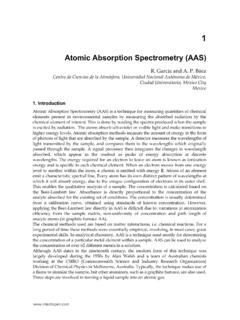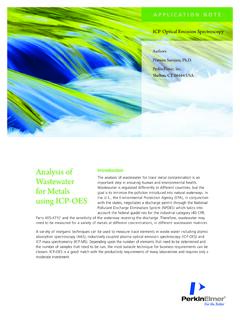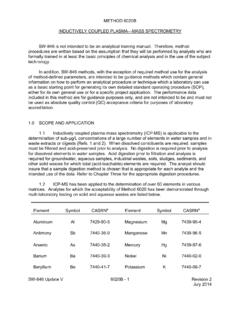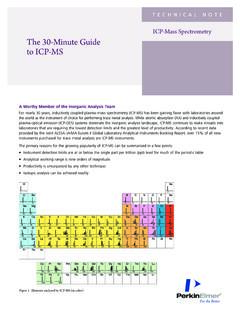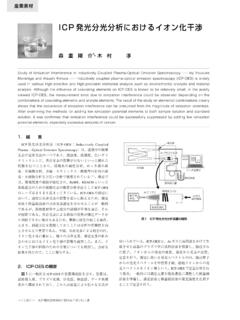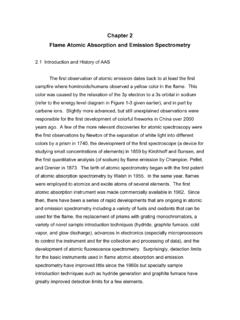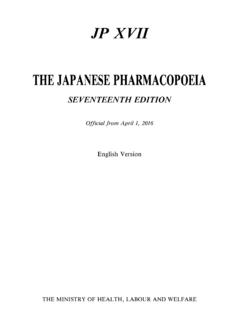Transcription of Guidelines for Chemical Analysis: Determination of the ...
1 Guidelines for Chemical Analysis Determination of the Elemental Content of Environment Samples using ICP-OES Dr. Heinz R del, Dr. Jan K sters, Ing. grad. Josef Sch rmann Fraunhofer Institute for Molecular Biology and Applied Ecology, Auf dem Aberg 1, D-57392 Schmallenberg Contents 1 .. 2 German Environmental Specimen Bank2 .. 2 General Information3 .. 2 Field of Application4 .. 3 .. 3 .. 3 Reagent blank .. 3 Blank .. 3 Interference5 .. 3 Description of the method6 .. 4 .. 4 Vessels for element .. 4 Emission spectrometer7 .. 4 ..4 .. 4 List of .. 4 Element stock .. 4 Multi-element standard solutions8 .. 5 ICP-OES measurement .. 5 General .. 5 Preparation of the.
2 5 .. 5 Check on equipment .. 5 Measurement of digestion .. 6 Validation of method9 .. 7 Interferences10 .. 7 Evaluation11 .. 8 Statement of results12 .. 8 Analysis report13 .. 9 Representative analysis results14 .. 9 BibliographyAppendix: Representative Analysis 10 Guidelines for sampling, transport, storage and Chemical characterisation of environmental and human samples July 2007, V 1 German Environmental Specimen Bank The German Environmental Specimen Bank (ESB) is an instrument for the monitoring of the environment. It is in the responsibility of the Fed-eral Ministry for the Environment, Nature Protec-tion and Reactor Safety (BMU) and technically and administratively coordinated by the Federal Environment Agency (Umweltbundesamt).
3 The ESB collects ecologically representative environ-mental specimens as well as human samples, stores them and examines the archived material for environmental relevant substances. The long-term storage is performed under condi-tions that exclude a change of state or a loss of Chemical characteristics as far as possible during a period of several decades. By this means the archive provides specimens for a retrospective monitoring of such substances, whose hazard potential for the environment or human health are not yet known. Comprehensive information on the German ESB is available at (Eng-lish language pages available).
4 2 General Information This guideline for the Determination of the Elemental Content of Environment Samples Using inductively coupled plasma optical Emission Spectrometry (ICP-OES) describes a method for quantifying the dissolved elements barium, calcium, cadmium, iron, potassium, magnesium, manganese, phosphorus, sulphur and zinc in digests of plant and animal sample material. The can also be used for determining the content of other elements detectable by means of ICP-OES in biological and environmental samples. This guideline is a continuation of the method Guidelines entitled Analytic Regulations for Elements and Species in Environmental Samples, Matrix Group 1 , developed by the Environmental Specimen Bank for analysing digests of environmental samples (UMWELTBUNDESAMT 1996).
5 It includes references from the German standard DIN EN ISO 11885 / DEV E22 Water Quality Determination of 33 Elements by inductively coupled plasma Atomic-Emission Spectrometry (1998) which is used for analysing acidic aqueous solutions ( acidified drinking water, waste water and other water samples, aqua regia extracts from soils and sediments). 3 Field of Application This guideline describes the procedure for examining digestions of environmental samples by means of ICP-OES. In the program of analysis pursued by the Environmental Specimen Bank, this guideline is regularly used for samples of the following types: bladder wrack (brown algae), spruce shoots, pine shoots, poplar leaves, beech leaves, earthworm.
6 The method described below can also be applied to other biological sample types. Where samples are used for which no empirical data are available, a suitable validation process should be applied (see section ). In each case, the working range of the method has to be adapted to the concentration of the elements in the digestion solutions. The lower range of application of the process described depends on the matrix in use and the errors connected therewith. For digested biological samples the typical limits of detection normally achieved are listed in table 1 (data refer to dry weights). In some cases, lower limits of detection are achievable, but the content of elements in the samples concerned here are higher.
7 The wavelengths are selected in accordance with the required limit of detection (section ) and the possibility of interference by other elements present in the digestion solution (section 9).2 Table 1: Recommended wavelengths to DIN EN ISO 11885 and ESB Guidelines Analytic Regulations for Elements and Species in Environmental Samples, Matrix Group 1 and typical limits of detection normally achieved by the method in the selected working range for the wavelengths used for environmental samples (bold). Element Wavelengths [nm] Limit of detection [ g/g]# Barium (Ba) - - Calcium (Ca) - 350 - Iron (Fe) - Potassium (K)
8 100 - Magnesium (Mg) $ - * 40 Manganese (Mn) - $ Phosphorus (P) 170 - - - Sulphur (S) 100 - Zinc (Zn) - # Calculation of solid content on the assumption that 200 mg of solid material is used for the digestion and then replenished to mL.
9 Wavelength of this element used for plant samples. * Wavelength of this element used for earthworm samples. $ Wavelength of this element used for bladder wrack samples (source: Thermo Instruments). 4 Terminology Sensitivity Slope of the regression lines indicating the relationship of the intensity of the signal to the concentration of an element. Reagent blank value An aqueous solution which has the same acid concentration as the calibration solutions and is treated in the same way as the digestion solutions under analysis. The purpose of reagent blank values is to identify the possible contamination by reagents, digestion and digestion vessels.
10 Blank value An aqueous solution which has the same acid concentration as the calibration solutions. The purpose of blank values is to check whether sample material has been carried-over from previous measurements and to ensure that the set rinsing time between measurements is adequate. Interference Interference is defined as any effect which distorts the signal where the concentration of the element being tested remains constant. A distinction is made between spectral interference (undesirable signals which interfere with the signal from an element), Chemical interference ( Chemical reactions which reduce the concentration of an element) and physical interference ( caused by differences in viscosity between standard and sample solutions).
